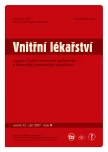QT dynamicity in risk stratification in patients after myocardial infarction
Authors:
T. Novotný 1; M. Šišáková 1; A. Floriánová 1; O. Toman 1; I. Dohnalová 1; M. Poloczek 1; P. Kala 1; I. Kyselová 1; L. Dostálová 1; P. Vít 2; J. Špinar 1
Authors‘ workplace:
Interní kardiologická klinika Lékařské fakulty MU a FN Brno, pracoviště Bohunice, přednosta prof. MUDr. Jindřich Špinar, CSc., FESC
1; II. dětská klinika Lékařské fakulty MU a FN Brno, pracoviště FDN J. G. Mendla, přednosta prof. MUDr. Zdeněk Doležel, CSc.
2
Published in:
Vnitř Lék 2007; 53(9): 964-967
Category:
Original Contributions
Overview
Background:
Ventricular repolarization abnormalities are associated with increased risk of sudden cardiac death in patients after myocardial infarction. The aim of this study is to assess QT dynamicity – QT/RR relationship – in patients after myocardial infarction and its contribution to risk stratification of sudden cardiac death.
Methods:
In a group of patients with diagnosis of acute myocardial infarction a long term ECG recording was performed 48–72 hours after myocardial infarction (MARS Unity Workstation, GE Medical Information Technologies). Patients with unstable circulation, artificial pulmonary ventilation, left bundle brach block, atrial fibrillation and paced rhythm were excluded. Analysis of QT dynamicity was performed by QT Guard software (GE Medical Information Technologies). QT/RR relationship is expressd by linear regression as QT = = aRR + b where „a“ is termed „slope“.
Results:
Assessment of QT dynamicity was possible in 215 ECG recordings. In 6-month follow-up 2 patients died and another was successfully resuscitated for primary ventricular fibrillation. Six-month mortality resp. mortality + resuscitation was 0.9 %, resp. 1.4 %. Therefore statistical evaluation was not possible. In the 3 mentioned individuals the slope values were 0.333, 0.249 and 0.342.
Conclusions:
Mortality of up-to-date-treated patients after myocardial infarction is low. Therefore, in such patients it is not possible to assess QT dynamicity as a risk factor in midterm follow-up. Limitation of the method is the necessity of substantial selection of patients elegible for analysis and dependance on necessary equipment.
Key words:
myocardial infarction – QT dynamicity – QT interval – sudden cardiac death
Sources
1. Schwartz PJ, Wolf MD. QT interval prolongation as predictor of sudden death in patients with myocardial infarction. Circulation 1978; 57 : 1074-1077.
2. Coumel P, Maison Blanche P. QT dynamicity as a predictor for arrhythmia development. In: Oto A, Breithardt G (Eds.) Myocardial repolarization: From gene to bedside. Armonk (NY): Futura Publishing 2001 : 173-186.
3. Schwartz PJ, La Rovere MT, Vanoli E. Autonomic nervous system and sudden cardiac death. Experimental basis and clinical observations for post-myocardial infarction risk stratification. Circulation 1992; 85(Suppl 1): I77-I91.
4. Laguna P, Thakor NV, Caminal P et al. New algorithm for QT interval analysis in 24‑Hour Holter ECG: performance and applications. Med Biol Eng Comp 1990; 28 : 67-73.
5. QT intervals in Mars Unity Workstation. GE Medical Information Technologies. 12-Mar-01 Rev. 1.0
6. Lecocq B, Lecocq V, Jaillon P. Physiologic relation between cardiac cycle and QT duration in healthy volunteers. Am J Cardiol 1989; 63 : 481-486.
7. Extremiana F, Maison-Blanche P, Badilini F et al. Circadian modulation of QT rate dependence in healthy volunteers. Gender and age differences. J Electrocardiol 1999; 32 : 33-43.
8. Merri M, Moss AJ, Benhorin J et al. Relation between ventricular repolarization duration and cardiac cycle lenght during 24-hour Holter recordings. Findings in normal patients and patients with long QT syndrome. Circulation 1992; 85 : 1816-1821.
9. Sharma PP, Sarma JSM, Singh BN. Effects of sotalol on the circadian rhythmicity of heart rate and QT intervals with noninvasive index of reverse-use dependency. J Cardiovasc Pharmacol Therapeut 1999; 4 : 15-51.
10. Yi G, Guo X, Reardon M et al. Circadian variation of the QT interval in patients with sudden cardiac death after myocardial infarction. Am J Cardiol 1998; 81 : 950-956.
11. Šišáková M, Toman O, Floriánová A et al. Analysis of QT dynamicity behaviour in relationship to the risk of sudden cardiac death - a pilot study. Scripta Medica 2005; 78 : 171-176.
12. Chevalier P, Burri H, Adeleine P et al. QT dynamicity and sudden death after myocardial infarction. J Cardiovasc Electrophysiol 2003; 14 : 227-233.
13. Jensen BT, Abildstrom SZ, Larroude CE et al. QT dynamics in risk stratification after myocardial infarction. Heart Rhythm 2005; 2 : 357-364.
14. Pathak A, Curnier D, Fourcade J et al. QT dynamicity: a prognostic factor for sudden cardiac death in chronic heart failure. Eur J Heart Failure 2005; 7 : 269-275.
15. Milliez P, Leenhardt A, Maisonblanche P et al. Usefulness of ventricular repolarization dynamicity in predicting arrhythmic deaths in patients with ischemic cardiomyopathy (from the European Myocardial Infarct Amiodarone Study). Am J Cardiol 2005; 95 : 821-826.
16. Camm AJ, Malik M, Yap YG. Measurement of QT interval and repolarization assessment. In: Camm AJ, Malik M, Yap YG. Acquired Long QT Syndrome. Oxford: Blackwell Futura 2004 : 24-59.
17. Smetana P, Batchvarov V, Hnatkova K et al. Ventricular gradient and nondipolar repolarisation components increase at higher heart rate. Am J Physiol Heart Circ Physiol 2004; 286: H131-H136.
Labels
Diabetology Endocrinology Internal medicineArticle was published in
Internal Medicine

2007 Issue 9
Most read in this issue
- Intraabdominal hypertension at intensive care units
- Chronic fatigue syndrome in cancer patients. Diagnostic and treatment options.
- Primary aldosteronism
- Early haemodynamic changes after radiofrequency ablation of the atrioventricular junction
